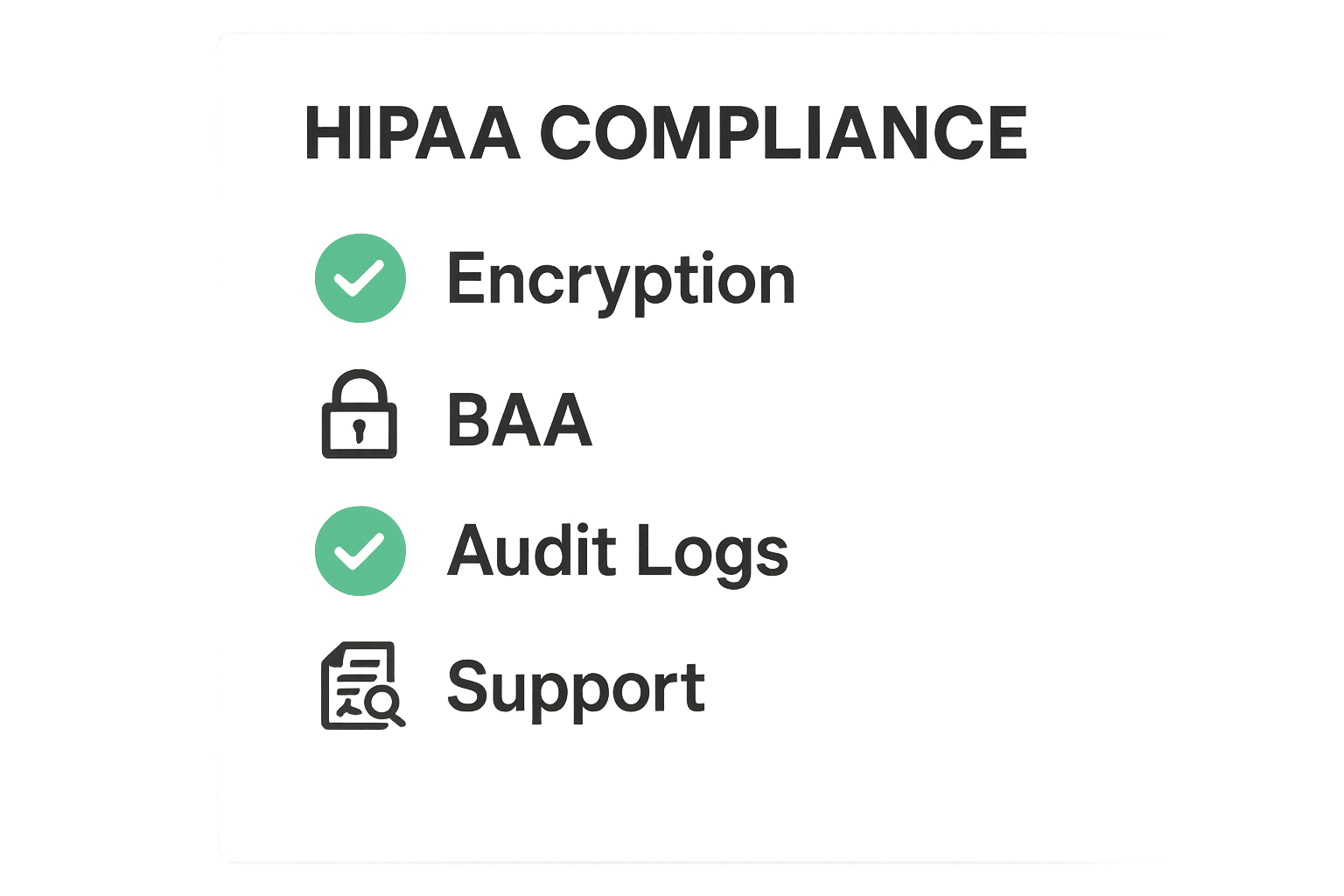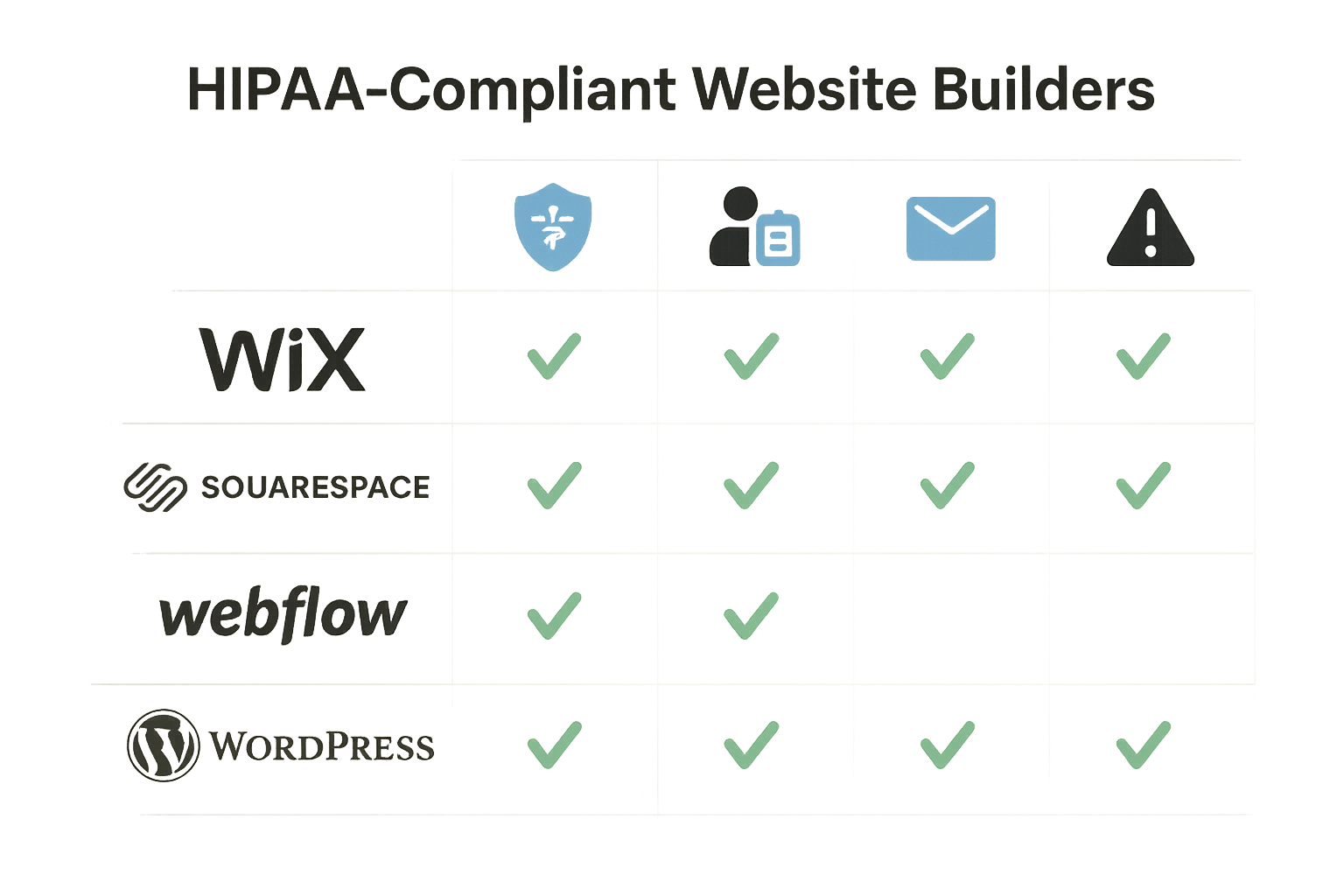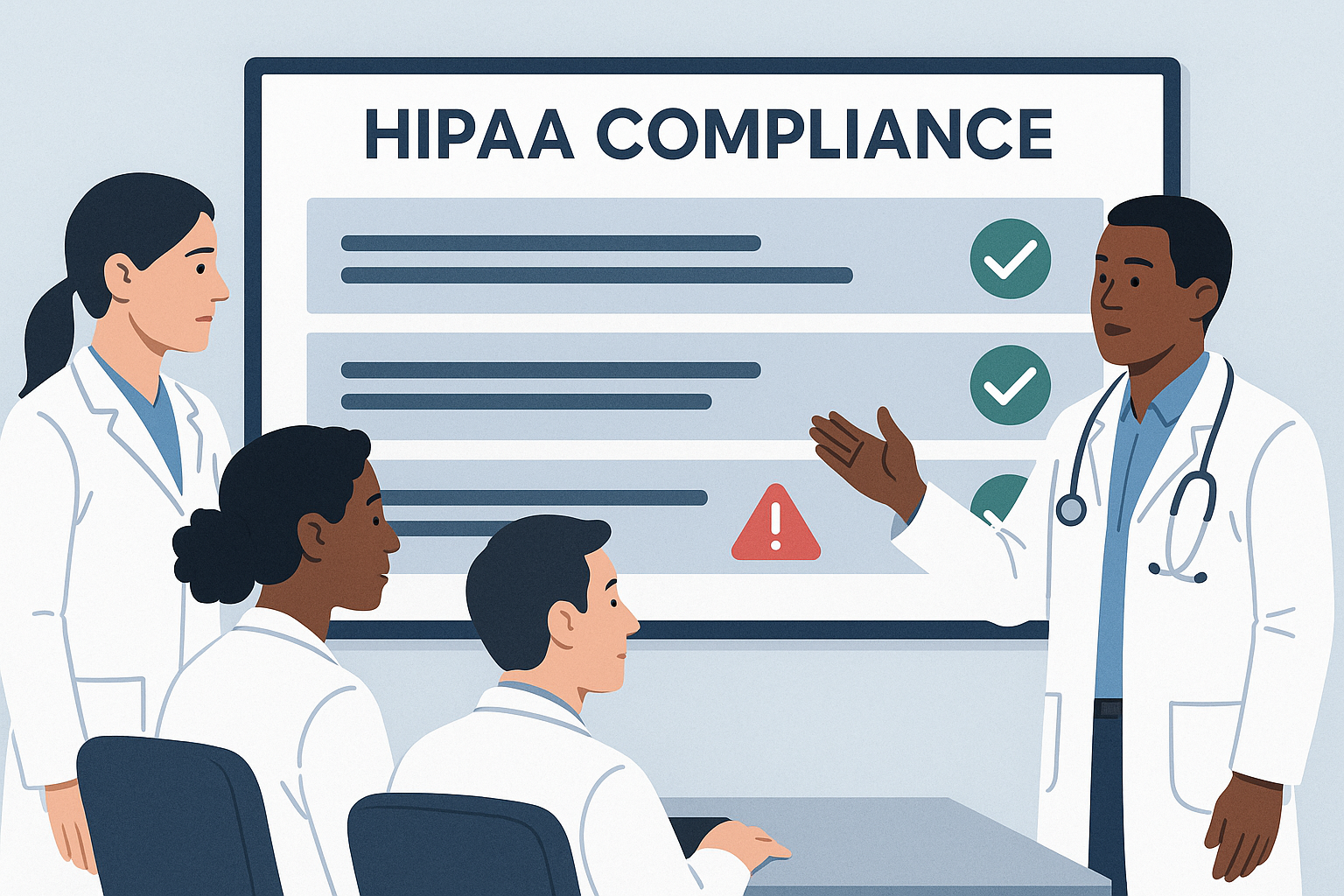Every healthcare provider knows HIPAA compliance is non-negotiable when it comes to patient data online.
But what exactly makes a website builder HIPAA-compliant?
In this complete cheatsheet, you’ll get an expert-curated list of the best HIPAA-compliant website builder options for healthcare in 2025—plus a practical step-by-step launch guide and ongoing best practices.
Some are all-in-one, no-code platforms built for speed.
Some are ultra-customizable, perfect for clinics with unique needs.
Some put design front and center, while others double down on ironclad security.
Some will save you money, and some are worth every penny for enterprise peace of mind.
Some help you avoid the most common—and costly—compliance mistakes.
Let's dive right in.
- What Is a HIPAA-Compliant Website Builder?
- Why You Need a HIPAA-Compliant Website Builder
- Key Criteria for Selecting a HIPAA-Compliant Website Builder
- Top 8 HIPAA-Compliant Website Builders for Healthcare (2025)
- Pricing, Features, and Support Comparison
- Step-by-Step Implementation Guide
- Best Practices for Long-Term HIPAA Website Compliance
- Conclusion & Next Steps
What Is a HIPAA-Compliant Website Builder?
A HIPAA-compliant website builder is a platform, tool, or service that enables healthcare professionals to create and manage websites that meet all the requirements of the Health Insurance Portability and Accountability Act (HIPAA) for safeguarding Protected Health Information (PHI). This means your site must have robust administrative, physical, and technical safeguards in place—from encrypted data storage to strict access controls and signed Business Associate Agreements (BAAs).
Simply put: if your website collects, stores, or transmits any patient data, HIPAA doesn’t just apply—it’s the law. Non-compliance can mean fines of up to $50,000 per incident, public shaming, and loss of patient trust (see case examples).

Why You Need a HIPAA-Compliant Website Builder
Understanding HIPAA Requirements for Websites
The HIPAA Security Rule mandates that all electronic PHI (ePHI) is protected by administrative, technical, and physical safeguards. For websites, this translates into:
- End-to-end encryption (SSL/TLS for data in transit, AES-256+ at rest)
- Access controls (unique logins, multi-factor authentication)
- Audit logs (tracking who accessed what and when)
- Data backup and disaster recovery plans
- Signed Business Associate Agreements (BAAs) with any service handling PHI
Even a simple contact form or appointment scheduler could expose PHI, so compliance isn’t just for patient portals—it’s for nearly every healthcare site with interactive features [source].
Risks and Penalties of Non-Compliance
HIPAA violations can trigger penalties up to $1.5 million annually per violation type, criminal charges, and mandatory public breach notifications. The reputational damage? Potentially devastating. A 2015 analysis found that more than two-thirds of audited healthcare organizations had significant technical shortfalls, and breaches are only getting bigger [see real examples].
Bottom line: If your website will ever touch PHI, you must use a HIPAA-compliant website builder—or risk your practice, your patients, and your peace of mind.
Key Criteria for Selecting a HIPAA-Compliant Website Builder
What separates a generic site builder from a true HIPAA-compliant solution? Here’s your critical checklist:
- Business Associate Agreement (BAA): The builder must provide a signed BAA outlining their legal responsibility to safeguard PHI. No BAA, no compliance—no exceptions.
- Robust Data Encryption: All data must be encrypted both in transit (SSL/TLS) and at rest (AES-256 or stronger).
- Hardened Hosting & Backups: Look for managed servers with firewalls, intrusion detection, and regular encrypted backups. Redundant systems are a must for fast disaster recovery.
- User Authentication & Access Controls: Features like multi-factor authentication, role-based permissions, and enforced strong passwords limit unauthorized access.
- Comprehensive Audit Logs & Monitoring: The platform should track data access and changes, alert you to suspicious activity, and facilitate easy compliance audits.
- Physical Security of Data Centers: The provider should outline physical access controls, surveillance, and breach response protocols.
- Dedicated Support & Compliance Documentation: You need 24/7 support and clear, up-to-date documentation proving compliance measures—especially if you’re ever audited [learn more].

Top 8 HIPAA-Compliant Website Builders for Healthcare (2025)
Ready to see which platforms lead the pack this year? Here’s our definitive list—each option handpicked for security, ease of use, and real-world compliance.
1. WordPress on WP Engine with HIPAA Add-on
Overview: Combine the world’s most popular CMS with WP Engine’s HIPAA compliance add-on for maximum flexibility and ironclad protection.
Features: Managed HIPAA hosting, signed BAA, SSL, daily encrypted backups, malware scanning, custom plugins for PHI forms, and on-demand audit logs. Scalable for everything from solo practices to large clinics.
Pricing: Starts at $115/month for the HIPAA plan, including security monitoring and 24/7 support.
Pros: Unmatched customization, vast plugin/theme ecosystem, excellent scalability.
Cons: Requires some technical/developer know-how. Maintenance is your responsibility.
2. Wix Enterprise with BAA
Overview: Wix’s Enterprise tier unlocks HIPAA compliance via a BAA, making it the most user-friendly drag-and-drop option for busy providers.
Features: Secure forms, SSL, 256-bit encryption, dedicated compliance support, and a highly intuitive editor. 900+ templates and 800+ apps for full design freedom.
Pricing: Custom, typically $200–$300/month depending on requirements.
Pros: No-code setup, blazing-fast deployment, beautiful templates, robust support.
Cons: Less backend flexibility compared to WordPress; HIPAA features only on Enterprise plans.
3. Squarespace Enterprise with HIPAA Support
Overview: The Apple of website builders—Squarespace’s Enterprise plan now includes HIPAA options and a BAA for select healthcare businesses.
Features: End-to-end SSL, role-based permissions, secure appointment scheduling, stunning design templates, and integrated analytics.
Pricing: From $200/month, scales with usage and add-ons.
Pros: Best-in-class design, simple to manage, reliable uptime.
Cons: Limited app marketplace, less customizable than WordPress.
4. Weebly Pro for Healthcare (by Square) with BAA
Overview: A cost-effective, easy-to-use builder with HIPAA compliance via Square’s BAA add-on.
Features: Automatic SSL, secure forms, monitoring, e-commerce tools for online billing and telehealth payments.
Pricing: $99/month plus a one-time $299 BAA setup fee.
Pros: Affordable, quick setup, solid for small clinics.
Cons: Fewer integrations, less flexible for advanced workflows.
5. Duda Agency Package with HIPAA Compliance
Overview: Built for agencies and multi-site operators, Duda offers white-label, HIPAA-ready sites with a signed BAA.
Features: Multi-site dashboard, collaborative page editing, SSL, client access controls, and automated backups.
Pricing: From $149/month per site for compliance features.
Pros: Ideal for agencies, great for scaling, easy collaboration.
Cons: Higher cost per site; may be overkill for solo practitioners.
6. BigCommerce with HIPAA-Ready Hosting
Overview: The enterprise e-commerce giant partners with HIPAA-compliant hosts for medical stores and complex content.
Features: Signed BAA, PCI-compliant checkout, server-side encryption, dedicated compliance architects, and 24/7 monitoring.
Pricing: Starts at $3,000/month; best for hospitals, large practices, and health systems.
Pros: Enterprise-grade support, robust e-commerce, tailored compliance help.
Cons: High cost, overkill for small providers.
7. GoDaddy Website Builder for Healthcare
Overview: GoDaddy’s healthcare-specific plans offer HIPAA compliance via select hosting tiers and a signed BAA.
Features: SSL, daily backups, malware protection, secure contact forms, and HIPAA-compliant email.
Pricing: $125–$175/month including all essentials.
Pros: All-in-one solution, easy for domain management, 24/7 support.
Cons: Less design flexibility compared to others.
8. Custom Solution on Liquid Web Managed Hosting
Overview: For ultimate control, build your site (WordPress, Drupal, or custom code) on Liquid Web’s HIPAA-compliant managed servers.
Features: Dedicated servers, full-disk encryption, signed BAA, intrusion detection, custom firewall rules, and expert support.
Pricing: Starts at $225/month per server with compliance add-on.
Pros: Total flexibility, scalable, excellent support.
Cons: Requires developer/admin expertise; ongoing maintenance needed.

Watch: How to Choose the Best Website Builder in 2025
Pricing, Features, and Support Comparison
Cost Breakdown by Tier
Entry-level HIPAA-compliant website builders start at $99–$200/month for basic features (Weebly, GoDaddy), mid-tier and enterprise options range from $200–$500/month (Wix, Squarespace, Duda), and enterprise e-commerce or custom hosting solutions can range from $1,000 to $3,000+/month (BigCommerce, Liquid Web).
| Builder | Starting Price | BAA Included? | Best For |
|---|---|---|---|
| WordPress/WP Engine | $115/mo | Yes | Custom, scalable sites |
| Wix Enterprise | $200–$300/mo | Yes | No-code, fast launch |
| Squarespace Enterprise | $200/mo | Yes | Design-first sites |
| Weebly Pro/Square | $99/mo + $299 setup | Yes | Small clinics |
| Duda Agency | $149/mo | Yes | Agencies/multi-clinic |
| BigCommerce | $3,000+/mo | Yes | Large e-commerce |
| GoDaddy | $125–$175/mo | Yes | All-in-one/turnkey |
| Liquid Web | $225/mo | Yes | Developer-led/custom |
Feature Matrix Overview
- All options: SSL, BAA, basic encryption, 24/7 support.
- Premium plans: Real-time monitoring, DDoS protection, dedicated compliance managers.
- Custom hosting: Maximum flexibility and control; best for practices with IT resources.
- Turnkey builders (Wix, Squarespace): Fastest path for non-technical users.
Support Levels and SLA Guarantees
Standard across the board is 99.9% uptime SLA and support within one hour for critical issues. Enterprise plans usually include a dedicated account manager and faster escalation.
Step-by-Step Implementation Guide
- Evaluate Your Healthcare Website Requirements
Map out your patient workflows, PHI collection points (forms, portals, payment), billing needs, expected traffic, and required third-party integrations (EHR, patient intake, telehealth). - Sign Your BAA Before Launching
Never collect or upload PHI until your builder signs a BAA. This is your legal protection and a compliance dealbreaker. - Configure DNS & Security Settings
Point your domain to the platform’s secure servers. Enable DNSSEC for added protection against spoofing attacks. - Enable Encryption and Set Up User Roles
Activate SSL/TLS, encrypted backups, and configure MFA for every admin. Define granular user roles (admin, editor, billing) with least-privilege access. - Test Security Before Going Live
Run vulnerability scans, simulate PHI form submissions, and review audit logs to verify all access is tracked. Fix any red flags before launch. - Educate Your Staff
Train your staff (front desk, billing, IT) on new procedures, password hygiene, and how to recognize phishing attempts. - Launch and Monitor
Go live, then monitor site access, logs, and alerts for unusual activity. Document everything for future audits [see detailed checklist].
Best Practices for Long-Term HIPAA Website Compliance
1. Regular Security Audits & Penetration Testing
Schedule quarterly vulnerability scans and annual penetration tests. Review audit logs monthly for anomalies or unauthorized access [more on compliant hosting].
2. Stay Up to Date with Patches
Update your CMS, plugins, and server software as soon as updates are released. Most breaches exploit unpatched systems.
3. Document All Policies & Training
Keep written documentation of all compliance policies, training attendance, and incident response plans. Update annually and after any change to your tech stack.
4. Control Access and Enforce Strong Authentication
Enforce unique logins, MFA, and least-privilege access. Never allow shared user accounts for PHI access.
5. Develop a Breach Response & Notification Plan
HIPAA requires prompt breach notification—often within 60 days, or as little as 5 days in some states. Have a clear process for response, patient notification, and regulatory reporting.
6. Use Secure, HIPAA-Ready Integrations Only
Any third-party app (from EHR to telehealth chat) must also sign a BAA. Vet all integrations for compliance before use.

Conclusion & Next Steps
Recap of Top Options
Every platform listed here—whether a fast-launch builder like Wix or a custom solution on Liquid Web—can help you achieve real HIPAA compliance. The best HIPAA-compliant website builder for your practice depends on your budget, technical resources, and specific feature needs.
How to Make Your Final Decision
- Start with a free trial or live demo (most providers offer this on request).
- Review the BAA terms and ask tough questions about audit logs, backups, and breach response.
- Test performance under simulated traffic and ensure easy integration with your current EHR or billing systems.
- Bring in IT, legal, and clinical staff to sign off—HIPAA compliance is a team sport.
With the right HIPAA-compliant website builder, you’ll deliver a secure, modern, and trust-building digital experience for your patients—and keep regulators off your back.
Need more guidance? For a deeper dive into HIPAA site compliance and the latest regulations, check out official government resources here and practical implementation guides here.
Published July 28, 2025. This cheatsheet will be updated regularly as platforms and regulations evolve.